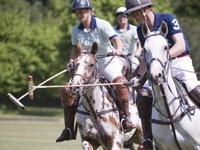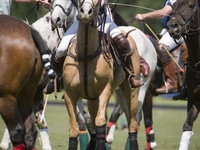WINDSOR, England—Under clear skies clear across the Atlantic Ocean, a clearly stronger Crimson team took to the field June 7 for the first-ever international Harvard-Yale polo match, breaking out to a 6-0 lead and holding on for a 6-5 victory at the Guards Polo Club in Windsor, England in front of an estimated 10,000 spectators.
No stranger to big matches, Guards is home to some of the premiere polo events in the world, including the world-renowned Vivari Queen’s Cup.
The Crimson and the Bulldogs represented the marquee matchup on the sunny June afternoon, drawing the largest crowd in the short tenure of the sponsorship of Jack Wills. Jack Wills is a British clothing retailer that’s popular among wealthy English students.
A history-filled day also saw Eton and Harrow match up for the 18th time as well as the 105th playing between Cambridge and Oxford. The latter schools met for the first time in November of 1878.
“It was quite an honor to get to play at Guards Polo Club,” rising senior Roy Willey said. “[It was a] great experience to have all the people there. Yale put up a good fight, we had a lot of fun, and I look forward to hopefully doing it again next year.”
The large crowd, which lined one of the world’s most prestigious fields, was far from disappointed. After witnessing a narrow 4-3 Harrow victory and a 4-0 win for Oxford, the Crimson seemed to have the match locked up, only to see the Bulldogs come storming back.
Down 6-0 just seconds into the third chukker, Yale rebounded from its slow start to steal the momentum, exploding for five unanswered goals. Spreading the ball around and following up teammates consistently leaving the ball behind them, three of the four Bulldog players posted goals. Rising senior Michael Losak started things off, and native Englishman David Ashby— Yale’s substitute, who was filling in for the recently injured Bulldog Robert Burk—added two scores. Unfortunately for Yale, time was not on its side, as the horn sounded just seconds after recent graduate Adam Nelson posted goal number five, ending all hopes for bragging rights and a comeback bid.
“It took a while to figure out [the] difference in dynamics between indoor and outdoor polo,” Losak said of his team, which plays almost solely indoor during the year. “Outdoor is far more about protecting the center because the field is so big. We had to really maneuver to take the inside.”
Playing a considerably more relaxed game after halftime, the Crimson was lucky to escape in the shortened match—despite likely being the stronger team. A typical polo match is divided into six, seven-and-a-half minute chukkers, or periods, with three minute breaks—five at halftime—to change horses between frames. The day’s matches featured just four chukkers.
Harvard came out fighting in the first chukker. Rising senior Nick Snow dominated the game early, scoring two of the Crimson’s first three goals and setting up teammate and recent graduate Alex Levin for the other to give Harvard a 3-0 lead to start the second chukker.
Things continued to go the Crimson’s way in the following frame, as Levin added goals four and five by halftime and number six early in the third chukker. Levin was awarded the honor of Most Valuable Player for his efforts.
“It’s really an unbelievable experience to play in front of 5,000 plus fans and to have them cheering as you go down the sidelines is really incredible,” Levin said. “Getting a chance to come to England was a once in a lifetime opportunity, and we showed that we were better than Yale this year.”
It was after that final Harvard goal that the tides turned, giving the fans the nailbiting finish that never should have been. Although the Crimson hardly outshined the Bulldogs overall on paper, the presence of three-goaler Snow was enough to give Harvard a significant advantage.
In polo, players are handicapped from -2 to 10 based on ability, with only the best of the best receiving a 10. Nobody on either side of the field boasted a mark above -1 other than Snow and Ashby.
The play of a single significantly higher rated player frequently changes the entire outlook of a game, and Snow’s did exactly that, as he controlled the ball and the match early before slowing down and laying off in the second half to even the playing field—opening the door for Yale’s coemback. While strong play from Ashby might have made up the difference, not playing for his own team he lacked the presence to do so fully.
With the first Harvard-Yale international polo match in the books, only time will tell whether next year will bring round two. But if Jack Wills has anything to say about it, the Crimson and Bulldog squads may find themselves in Windsor once again next June.
“We would love to have Harvard and Yale back,” said Jack Wills representative Olly Finding. “They drive new interest as an exhibition game. This is hopefully the start of a lifetime partnership with Jack Wills.”
—Staff writer Madeleine I. Shapiro can be reached at mshapiro@fas.harvard.edu.
Read more in Sports
Weekend Sweep Claims 27th Ivy Title
















